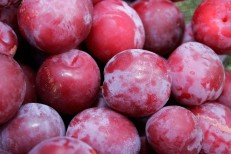Related Posts
A spectacular celebration
On July 4th, my husband, Bernard, and I went to Kenan Stadium to see the fireworks sponsored by the Town of Chapel Hill, and it was a lot of fun. The large, happy crowd was amazingly diverse–a veritable melting pot of age, race and ethnicity. We reveled in it! The fireworks were truly awesome. They sparkled, twinkled and swirled in the most amazing colors, shapes and combinations. It was a wonderful way to celebrate the 4th and made me think with affection of my Grandfather David, who had come to this country from Lithuania with almost no money and no English to become a citizen in 1914.
Where have all the good plums gone?
Bernard and I began the holiday with a plum tasting—a small one, part of my attempt to find plums that taste like those my family used to get on the way to the beach in Revere and Swampscott, Mass. It’s such a vivid sensory memory, and I still can taste the wonderful sweet/tart intense flavors of those plums that we’d eat on the beach during an afternoon outside, body-surfing waves and exulting in the sun (long before people knew the dangers of sun exposure). This year, particularly, fruit doesn’t seem to have intense flavor, no matter where I buy it. One day, I went to three different grocery stores just to get blueberries with flavor. They were all bland. One of the real joys of summer for me always has been looking forward to the arrival of summer fruits. But then, there used to be seasons, and we’d eat what was in season.
The good news is that I haven’t lost my sense of taste. The bad news: there seems to be less to taste, and that is sad. But I am not giving up yet. Maybe one of our local farmers’ markets has the flavorful fruit I’m craving. Or maybe you know the secret locations for good plums. I’ll keep you posted, and hope you’ll do the same. Barbara
 In search of flavorful fruit
In search of flavorful fruit
Apparently, I am not the only one who craves fruit with flavor. I found thousands of web hits for bland fruit with comments like this from The Kitchn and this from the Daily Mail:
And yet, walk along the chiller cabinets in the fruit and vegetable section of any big supermarket and I can almost guarantee you’ll find three things — strawberries from Morocco or Spain, green beans from Kenya and sad, film-wrapped baby asparagus all the way from Peru.
They’ll be there today, tomorrow and any day you care to mention — except for a few short but glorious weeks in spring and summer when they are replaced by the home-grown alternative.
They are ubiquitous, unappetising and completely unaffected by the passing of the seasons.
But who in their right mind wants to eat imported strawberries in January or asparagus come to that?
The former taste unpleasantly of cucumber, while the latter always seems to have a nasty taint of tin.
And yet millions of us buy them, dazzled by the marketing and the ability of supermarkets to offer just about any crop in the world at just about any time of year.
From the blog Gizmodo comes this commentary on Fuji apples:
Apples aren’t the same either. Fuji apples were, once upon a time, objectively and irrefutably the most delicious apples you could sink your teeth into—anyone who said otherwise was either a liar or a witch. These days, though, Fuji apples just aren’t quite hitting the spot like they used to, and we might never see them reach their former glory again.
By comparing samples of modern-day Fujis to similar studies from the 70s, a team of researchers has discovered that the formerly glorious Fuji has recently grown substantially mealier and has a lower flavor concentration. The likely culprit? Our old friend climate change.
Coming from Japan, the researchers actually compared both modern-day Fujis and modern-day Tsugarus to their healthier, presumably groovier 70s counterparts. They found that the concentration of malic acid—which is a large part of what gives apples their taste—has been slowly declining over the past few decades along with the apples’ firmness. What’s more, today’s apples are far more suspectible to watercore, a disease that causes apples to start breaking down internally as soon as they mature. So on top of everything else, today’s apples are more disease prone, too.
